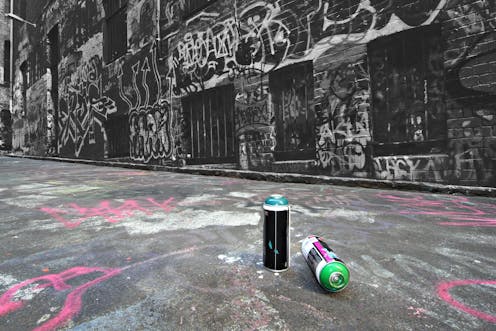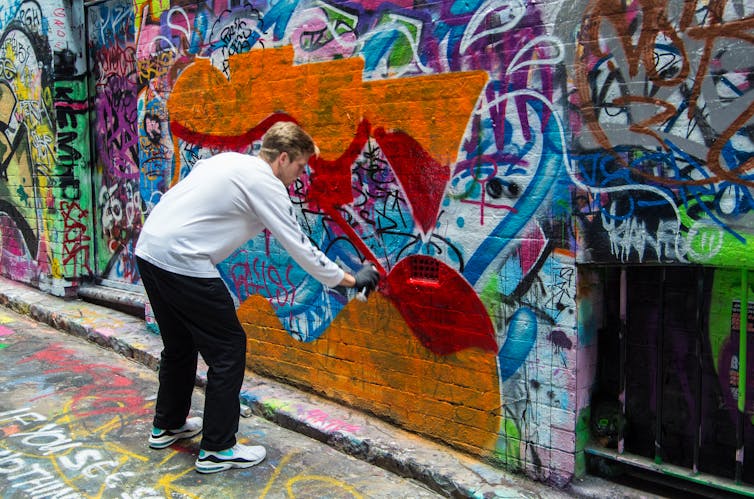Source: The Conversation (Au and NZ) – By Flavia Marcello, Professor of Design History, Swinburne University of Technology

Shutterstock
In 1985 photographer Rennie Ellis defined graffiti as “the result of someone’s urge to say something – to comment, inform, entertain, persuade, offend or simply to confirm his or her own existence here on earth”. Since the mid-1980s, graffiti has crossed from vandalism to an accepted form of art practice through large murals or “pieces” and stencil art aimed at informing, entertaining and persuading us.
But these are outnumbered by the tags you see everywhere. These stylised icon-type signatures define a hand style and confirm their author’s existence on Earth. These, for many of us, remain an eyesore. If you walk through an urban environment filled with tags, you may feel less safe. Heavily tagged areas can suggest the area is not cared for or surveilled.
So why are Australian cities so full of tags? The problem is, the main solution proven to work is expensive. When tags go up, paint over them – and keep doing it. While anti-graffiti paint exists, it’s not widely used at present.
Why do people tag?
Graffiti in urban centres is often tied to the world-wide proliferation of hip-hop culture. Along with DJing, rapping and breakdancing, “Graf” or “writing” is considered one of its four pillars.
Posturing (or showing off) is a big part of tagging. When you see a tag on a freeway overpass or seemingly inaccessible building parapet, it’s not only confirming the tagger’s existence, it’s bragging. See how high I climbed! See what crazy risks I took!
As one tagger in Sydney’s outer south-western suburb of Campbelltown told researchers in the 1980s:
If you get on a train and see your name and know you’ve been here before that’s real good. Like, I was here. Or you see your mate’s name and you can say, hey, I know him […] It’s really good if you can get your name up in a difficult place where nobody else has. Other kids look at that and think, great!

Scott Sandars/Flickr, CC BY
So why do people tag?
-
it boosts self-esteem and a sense of belonging to a social network, particularly for teens experiencing alienation at school
-
it demonstrates bravado. Risky places have the added advantages of being both highly visible and harder to remove
-
it gives graf artists practice for bigger pieces. You have to work quickly and accurately, especially in precarious positions where you could get caught at any moment.
While cities like Melbourne have embraced larger murals and pieces as street art – even making them a tourist attraction – tagging isn’t regarded the same way.

Shutterstock
So why do non-taggers hate it? On a broader level, tagging can signify a sense of social degradation which makes people feel less safe.
There’s no clear link between more graffiti and more crime. Even so, the public perception is that tagging is a sign warning of the presence of disaffected and potentially violent people in gangs.
Asked to picture a tagger and you will most likely come up with a stock photo stereotype: a male teenager in a hoodie from a seedy area. But you would not be completely right. It is true just under half (46%) of graffiti damage and related offences are committed by 14 to 16 year old males, but the largest percentage of offenders actually come from middle- to high-income families.
So what tools do we have to manage it?
Punishment
It’s perfectly legal to commission a graf artist to paint a wall of a building you own. Many people do this to avoid a street-facing wall being tagged. For it to be illegal, tagging or graffiti has to be done without the owner’s permission.
Since the majority of taggers are under 18, if they’re caught, punishment will usually include a caution, fines (presumably paid by bemused but cashed up parents) and cleaning off tags.
But punitive measures only go so far because the appeal of graffiti is the transgression. Other measures include keeping spray paint locked away or not for sale to under 18s as well as zero-tolerance rapid removal. This can work for a while, but taggers know their tags are temporary. It’s a constant game of cat and mouse a committed tagger will eventually win.
Technical solutions
If you’ve walked past workers scrubbing or pressure washing tags off walls, you may have wondered why there are no coatings which don’t let paint stick.
These actually do exist, and can work well. When in place, you can remove graffiti with a solvent rather than having to repaint. But they’re not widely used.
Unless paints such as Deletum 3000 are used everywhere this approach is unlikely to be effective.
Prevention
The problem with punitive and technical measures is the limited reach. The vast majority of unwanted graffiti goes unreported. That’s why prevention is becoming more popular.
How do you prevent tagging? By making it easier to report. By setting aside areas for taggers and graf artists. By commissioning pieces to deter graffers from illegal modes. And by talking directly to taggers about strategies. But these behaviour change efforts take time.
People who hate tagging often believe taggers are motivated by negative emotions such as boredom and rebelliousness. For them it’s vandalism, a criminal act associated with gangs, petty crime, broken windows and a less attractive environment to live in.
But the truth is, taggers are often motivated by positive emotions. Tagging, for them, brings pride, pleasure, enjoyment and community. That’s why behaviour change approaches can be hard.
So what’s the best way forward?
In the 1990s, many cities declared war on skateboarders, using punishment and installing metal stoppers on well-skated urban areas. But the real solution was simpler: create skate parks.
For taggers, the answer may be similar. Give them spaces such as little-used alleyways to practise their art. And for the rest of us, the solution may be to look at tags with different eyes. Not as a sign of crime and the collapse of civilisation, but as a need for validation, for transgression, for community and all the other things you probably wanted when you were a teenager.
![]()
Flavia Marcello does not work for, consult, own shares in or receive funding from any company or organisation that would benefit from this article, and has disclosed no relevant affiliations beyond their academic appointment.
– ref. Transgress to impress: why do people tag buildings – and are there any solutions? – https://theconversation.com/transgress-to-impress-why-do-people-tag-buildings-and-are-there-any-solutions-205492







